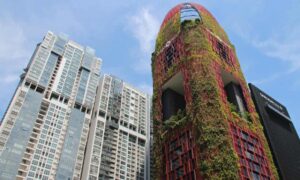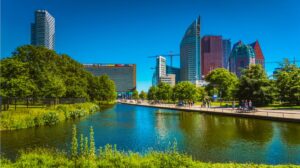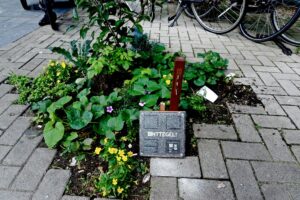Urban Studies Community
Heating up: Summer in the city
Geplaatst in NewsFlash, Urban Studies.
It’s summer! Hoping for as many sunny days as possible, going to the beach for a swim to cool down, eating ice cream…
But also: Vehicles stuck in traffic emitting heat. Airconditioners pumping waste heat into the air. Concrete and asphalt across almost every surface, absorbing and radiating the sun’s rays. These are some of the factors that contribute towards a phenomenon called the “urban heat island” effect, which results in cities being up to 10C hotter than the surrounding countryside.
There are several ways of adapting a city to tackle this problem. For example like they do in Singapore, with sky gardens. Many cities recognize the value of parks and trees for urban cooling, not to mention residents’ psychological wellbeing, but few have embraced greenery to the extent of Singapore. The city-state embarked on its ambitious “garden city” plan in 1967 through intensive tree-planting and the creation of new parks. Some buildings are even completely covered in green!

Another way is reflective roofs and streets, by making them white instead of the dark, heat-absorbing colors they usually have. It may sound simple, but the results can be significant – research by Nasa has suggested a white roof could be 23C (42F) cooler than a typical black roof on the hottest day of the New York summer.
And also, water cools down cities. Cities are accommodating ponds, pools, fountains, sprinklers and misting systems to cool outdoor spaces.

How are we doing in The Hague?
The heat island effect is mainly present in the districts of Centrum, Laak and Scheveningen. These districts were also most affected by the heat in previous years. The main cause there is lack of space. The ‘Haagse Hitte onderzoek’ (The Hague Heat Research) shows a direct link between lack of space and temperature. The most important factors are: a lot of pavement, little vegetation, little reflection, little surface water and the building volume. A broad approach is necessary to cool these districts.
“The heat island effect is really there,” says Frank van de Hoeven, director of Research at the Faculty of Architecture at TU Delft. According to him, the heat stress of recent years is a reason for a policy approach to the heat island effect. The Hague can expect warmer summers in the future. The research describes seven adaptive solutions for reducing the heat island effect in the city. These solutions are: replacing the asphalt roofs, reducing urban pavement, greening the inner courtyards, keeping buildings cool, monitoring heating of homes, preserving buffer zones and realizing green icons.
Extreme showers
Not only heat, also extreme rain showers form a threat. Due to increasing rainfall, it is important that the sewage system in The Hague is burdened as little as possible and that rainwater is drained properly. The municipality will design streets in such a way that the risk of damage is limited in the event of extreme rain showers. In addition, the municipality provides options for storing the water. Examples are the construction of the Molenvlietpark calamity storage in the Leidschenveen-Ypenburg district, the green roof on the Zuiderpark Sports Campus in the Escamp district and the Sand Motor at the Loosduinen district.
What can people in The Hague do themselves?
If you’re living in The Hague, you can help make the city resistant to nuisance from heavy rain showers by:
- Investing in a green roof
A green roof not only provides good insulation for your home, but also ensures that a lot of rainwater is absorbed before it reaches the ground. You can receive a subsidy from the municipality for the construction of a green roof.

- Participating in Operation Steenbreek (Breaking the stones/tiles)
The urbanization of the city has unpleasant consequences: the city is getting warmer, more particulate matter in the air, rainwater cannot drain properly, more floods, less space for bees, butterflies and birds and much more. By removing tiles from your garden and placing plants in their place, rainwater is absorbed faster and the sewer is less burdened. The municipality is participating in this national campaign with more municipalities to make the surrounding area greener and more climate-proof. Read more on the Duurzaam Den Haag (Sustainable The Hague) website.
If you don’t own an apartment with a roof or a garden, you could ofcourse always tell your friends and family about these initiatives and convince them to join!
——
Sources:
https://ruimtelijkeadaptatie.nl/actueel/actueel/nieuws/2018/haagse-hitte/
https://www.theguardian.com/cities/2018/aug/15/what-heat-proof-city-look-like
